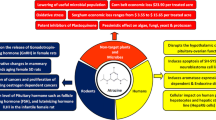Abstract
A simple analytical method for the determination of p-nitrobenzene-azo-naphthol was proposed by a sequential perturbation with different amounts of p-nitrobenzene-azo-naphthol on an oscillating chemical system. The method involves a Cu(II)-catalysed oscillating reaction between hydrogen peroxide and sodium thiocyanate in alkaline medium with the aid of continuous-flow stirred tank reactor (CSTR). A good linear relationship between the changes, oscillation amplitude or/and period, and the concentration of p-nitrobenzene-azo-naphthol was obtained. The use of analyte pulse perturbation technique provides a possibility of sequential determination in a same oscillating system, due to a new steady state that reappeared rapidly after each perturbation. The calibration curve fits a linear equation very well when the concentration of p-nitrobenzene-azo-naphthol ranging from 5.2×10−7 to 3.3×10−3M. Influence of temperature, injection point, flow rate and reactants variables on this system were investigated in detail.
Similar content being viewed by others
References
L.P. Tikhonova, L.N. Zakrevskaya and K.B. Yasimirskii: “Catalytic dtermination of ruthenium based on an oscillating chemical reaction”, J. Anal. Chem. USSR, Vol. 33, (1978), pp. 1991–1998.
R. Jimenez-Prieto, M. Silva and D. Perez-Bendito: “Approaching the use of oscillating reactions for analytical monitoring”, Analyst, Vol. 123, (1998), pp. 1R-8R.
A.F. Taylor: “Mechanism and phenomenology of an oscillating chemical reaction”, Prog. React. Kinet. Mec., Vol. 27(4), (2002), pp. 247–325.
J.Z. Gao: “Application of oscillating chemical reaction to analytical chemistry: Recent Developments”, Pak. J. Biol. Sci., Vol. 8(5), (2005), (im press).
J.Z. Gao, J. Ren, W. Yang, X.H. Liu and H. Yang: “Determination of caffeine using oscillation chemical reaction in a CSTR”, J. Pharmaceut Biomed., Vol. 32, (2003), pp. 393–400.
J.Z. Gao, H. Yang, X.H. Liu, J. Ren, Q.Z. Li and J.W. Kang: “Determination of glutamic acid by an oscillating chemical reaction using the analyte pulse perturbation technique”, Talanta, Vol. 57, (2002), pp. 105–114.
J.Z. Gao, H. Yang, X.H. Liu, J. Ren, X.Q. Lu, J.G. Hou and J.W. Kang: “Kinetic determination of ascorbic acid by the BZ oscillating chemical system”, Talanta, Vol. 55, (2001), pp. 99–107.
J.Z. Gao, J. Ren, W. Yang, X.H. Liu, H. Yang, Q.Z. Li and H.L. Deng: “Kinetic determination of hydroquinone by Belousov-Zhabotinsky oscillating chemical reaction”, J. Electroanal. Chem, Vol. 520, (2002), pp. 157–162.
N.Q. Gan, C.J. An, Y. Liu and R.X. Cai: “Determination of hexacyanoferrates based on the diacetone −BrO −3 −Mn(II)−H2SO4 chemical oscillatory reaction”, Analyst, Vol. 123, (1998), pp. 2395–2397.
R. Jimenez-Prieto, M. Silva and D. Perez-Bendito: “Simultaneous determination of gallic acid and resorcinol based on oscillating chemical reaction by the analyte pulse pertuebation technique”, Anal. Chim. Acta, Vol. 334, (1996), pp. 323–330.
R. Jimenez-Prieto, M. Silva and D. Perez-Bendito: “Determination of gallic acid by an oscillating chemical reaction using the analyte pulse pertuebation technique”, Anal. Chim. Acta, Vol. 321, (1996), pp. 53–60.
R. Jimenez-Prieto, M. Silva and D. Perez-Bendito: “Application of oscillating reaction based on the determination of real samples”, Analyst, Vol. 122, (1997), pp. 287–292.
R. Jimenez-Prieto, M. Silva and D. Perez-Bendito: “Analytical assessment of the oscillating chemical reaction by use chemiluminescence detection”, Talanta, Vol. 44, (1997), pp. 1463–1472.
J. Wang, S.T. Yang, R.X. Cai, Z.X. Lin and Z.H. Liu: “A new method for determination of uric acid by the lactic acid-acetone-BrO −3 −Mn2+−H2SO4 oscillating reaction. Talanta, Vol. 65, (2005), pp. 799–805
M. Orban: “Oscillations and bistability in the Cu(II)-catalyzed reaction between H2O2 and KSCN”, J. Am. Chem. Soc., Vol. 108, (1986), pp. 6893–6898.
Author information
Authors and Affiliations
About this article
Cite this article
Gao, J., Sun, K., Yang, W. et al. Determination of p-nitrobenzene-azo-naphthol by an oscillating chemical reaction using the analyte pulse perturbation technique. cent.eur.j.chem. 3, 502–510 (2005). https://doi.org/10.2478/BF02479278
Received:
Accepted:
Issue Date:
DOI: https://doi.org/10.2478/BF02479278




